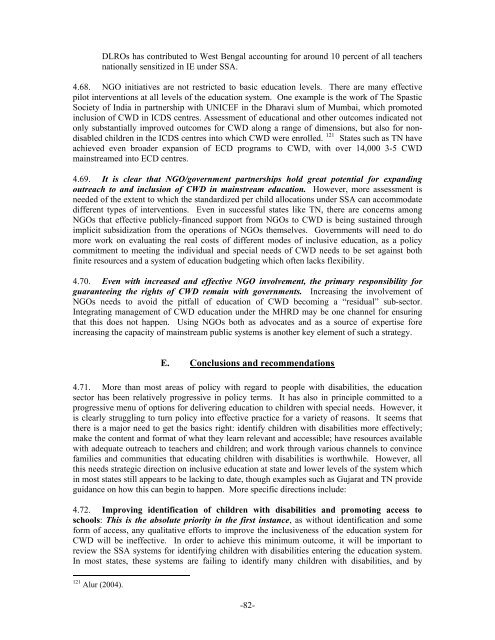People with Disabilities in India: From Commitment to Outcomes
People with Disabilities in India: From Commitment to Outcomes
People with Disabilities in India: From Commitment to Outcomes
You also want an ePaper? Increase the reach of your titles
YUMPU automatically turns print PDFs into web optimized ePapers that Google loves.
DLROs has contributed <strong>to</strong> West Bengal account<strong>in</strong>g for around 10 percent of all teachers<br />
nationally sensitized <strong>in</strong> IE under SSA.<br />
4.68. NGO <strong>in</strong>itiatives are not restricted <strong>to</strong> basic education levels. There are many effective<br />
pilot <strong>in</strong>terventions at all levels of the education system. One example is the work of The Spastic<br />
Society of <strong>India</strong> <strong>in</strong> partnership <strong>with</strong> UNICEF <strong>in</strong> the Dharavi slum of Mumbai, which promoted<br />
<strong>in</strong>clusion of CWD <strong>in</strong> ICDS centres. Assessment of educational and other outcomes <strong>in</strong>dicated not<br />
only substantially improved outcomes for CWD along a range of dimensions, but also for nondisabled<br />
children <strong>in</strong> the ICDS centres <strong>in</strong><strong>to</strong> which CWD were enrolled. 121 States such as TN have<br />
achieved even broader expansion of ECD programs <strong>to</strong> CWD, <strong>with</strong> over 14,000 3-5 CWD<br />
ma<strong>in</strong>streamed <strong>in</strong><strong>to</strong> ECD centres.<br />
4.69. It is clear that NGO/government partnerships hold great potential for expand<strong>in</strong>g<br />
outreach <strong>to</strong> and <strong>in</strong>clusion of CWD <strong>in</strong> ma<strong>in</strong>stream education. However, more assessment is<br />
needed of the extent <strong>to</strong> which the standardized per child allocations under SSA can accommodate<br />
different types of <strong>in</strong>terventions. Even <strong>in</strong> successful states like TN, there are concerns among<br />
NGOs that effective publicly-f<strong>in</strong>anced support from NGOs <strong>to</strong> CWD is be<strong>in</strong>g susta<strong>in</strong>ed through<br />
implicit subsidization from the operations of NGOs themselves. Governments will need <strong>to</strong> do<br />
more work on evaluat<strong>in</strong>g the real costs of different modes of <strong>in</strong>clusive education, as a policy<br />
commitment <strong>to</strong> meet<strong>in</strong>g the <strong>in</strong>dividual and special needs of CWD needs <strong>to</strong> be set aga<strong>in</strong>st both<br />
f<strong>in</strong>ite resources and a system of education budget<strong>in</strong>g which often lacks flexibility.<br />
4.70. Even <strong>with</strong> <strong>in</strong>creased and effective NGO <strong>in</strong>volvement, the primary responsibility for<br />
guarantee<strong>in</strong>g the rights of CWD rema<strong>in</strong> <strong>with</strong> governments. Increas<strong>in</strong>g the <strong>in</strong>volvement of<br />
NGOs needs <strong>to</strong> avoid the pitfall of education of CWD becom<strong>in</strong>g a “residual” sub-sec<strong>to</strong>r.<br />
Integrat<strong>in</strong>g management of CWD education under the MHRD may be one channel for ensur<strong>in</strong>g<br />
that this does not happen. Us<strong>in</strong>g NGOs both as advocates and as a source of expertise fore<br />
<strong>in</strong>creas<strong>in</strong>g the capacity of ma<strong>in</strong>stream public systems is another key element of such a strategy.<br />
E. Conclusions and recommendations<br />
4.71. More than most areas of policy <strong>with</strong> regard <strong>to</strong> people <strong>with</strong> disabilities, the education<br />
sec<strong>to</strong>r has been relatively progressive <strong>in</strong> policy terms. It has also <strong>in</strong> pr<strong>in</strong>ciple committed <strong>to</strong> a<br />
progressive menu of options for deliver<strong>in</strong>g education <strong>to</strong> children <strong>with</strong> special needs. However, it<br />
is clearly struggl<strong>in</strong>g <strong>to</strong> turn policy <strong>in</strong><strong>to</strong> effective practice for a variety of reasons. It seems that<br />
there is a major need <strong>to</strong> get the basics right: identify children <strong>with</strong> disabilities more effectively;<br />
make the content and format of what they learn relevant and accessible; have resources available<br />
<strong>with</strong> adequate outreach <strong>to</strong> teachers and children; and work through various channels <strong>to</strong> conv<strong>in</strong>ce<br />
families and communities that educat<strong>in</strong>g children <strong>with</strong> disabilities is worthwhile. However, all<br />
this needs strategic direction on <strong>in</strong>clusive education at state and lower levels of the system which<br />
<strong>in</strong> most states still appears <strong>to</strong> be lack<strong>in</strong>g <strong>to</strong> date, though examples such as Gujarat and TN provide<br />
guidance on how this can beg<strong>in</strong> <strong>to</strong> happen. More specific directions <strong>in</strong>clude:<br />
4.72. Improv<strong>in</strong>g identification of children <strong>with</strong> disabilities and promot<strong>in</strong>g access <strong>to</strong><br />
schools: This is the absolute priority <strong>in</strong> the first <strong>in</strong>stance, as <strong>with</strong>out identification and some<br />
form of access, any qualitative efforts <strong>to</strong> improve the <strong>in</strong>clusiveness of the education system for<br />
CWD will be <strong>in</strong>effective. In order <strong>to</strong> achieve this m<strong>in</strong>imum outcome, it will be important <strong>to</strong><br />
review the SSA systems for identify<strong>in</strong>g children <strong>with</strong> disabilities enter<strong>in</strong>g the education system.<br />
In most states, these systems are fail<strong>in</strong>g <strong>to</strong> identify many children <strong>with</strong> disabilities, and by<br />
121 Alur (2004).<br />
-82-










